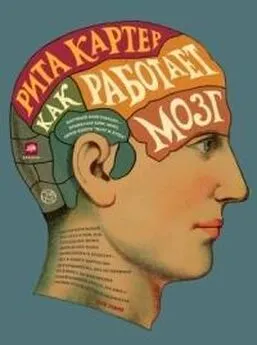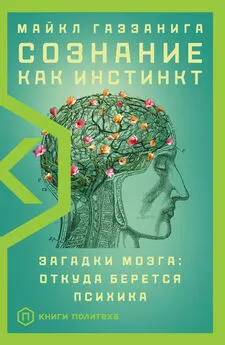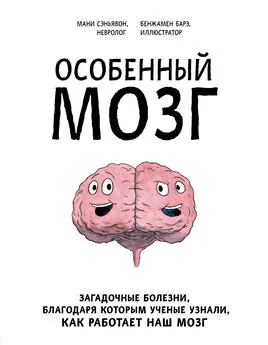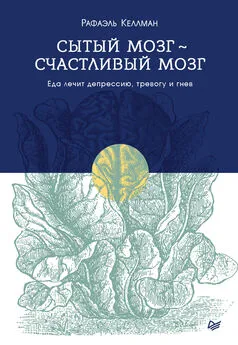Дин Бернетт - Счастливый мозг. Как работает мозг и откуда берется счастье
- Название:Счастливый мозг. Как работает мозг и откуда берется счастье
- Автор:
- Жанр:
- Издательство:Эксмо
- Год:2018
- Город:Москва
- ISBN:978-5-04-095041-6
- Рейтинг:
- Избранное:Добавить в избранное
-
Отзывы:
-
Ваша оценка:
Дин Бернетт - Счастливый мозг. Как работает мозг и откуда берется счастье краткое содержание
Счастливый мозг. Как работает мозг и откуда берется счастье - читать онлайн бесплатно ознакомительный отрывок
Интервал:
Закладка:
316
Atkinson, J.W., Motivational determinants of risk-taking behavior. Psychological review, 1957. 64 (6p1): p. 359.
317
Samson, A.C. and J. J. Gross, Humour as emotion regulation: the differential consequences of negative versus positive humour. Cogn Emot, 2012. 26 (2): p. 375–84.
318
Gil, M., et al., Social reward: interactions with social status, social communication, aggression, and associated neural activation in the ventral tegmental area. Eur J Neurosci, 2013. 38 (2): p. 2308–18.
319
Goh, C. and M. Agius, The stress-vulnerability model how does stress impact on mental illness at the level of the brain and what are the consequences? Psychiatr Danub, 2010. 22 (2): p. 198–202.
320
Gelkopf, M., S. Kreitler, and M. Sigal, Laughter in a Psychiatric Ward: Somatic, Emotional, Social, and Clinical Influences on Schizophrenic Patients. The Journal of nervous and mental disease, 1993. 181 (5): p. 283–289.
321
Flett, G.L., K. R. Blankstein, and T. R. Martin, Procrastination, negative self-evaluation, and stress in depression and anxiety, in Procrastination and task avoidance. 1995, Springer: p. 137–167.
322
Sørensen, L.B., et al., Effect of sensory perception of foods on appetite and food intake: a review of studies on humans. International journal of obesity, 2003. 27 (10): p. 1152.
323
Myers Ernst, M. and L. H. Epstein, Habituation of responding for food in humans. Appetite, 2002. 38 (3): p. 224–34.
324
Brennan, P., H. Kaba, and E. B. Keverne, Olfactory recognition: a simple memory system. Science, 1990. 250 (4985): p. 1223–1226.
325
Maldarelli, C., Here’s Why Twin Studies Are So Important To Science And NASA, in Popular Science. 2016, @popsci: popsci.com.
326
Kendler, K.S., et al., A Swedish national twin study of lifetime major depression. Am J Psychiatry, 2006. 163 (1): p. 109–14.
327
Kensinger, E.A. and S. Corkin, Two routes to emotional memory: Distinct neural processes for valence and arousal. Proceedings of the National Academy of Sciences of the United States of America, 2004. 101 (9): p. 3310–3315.
328
Hoffmann, H., E. Janssen, and S. L. Turner, Classical conditioning of sexual arousal in women and men: effects of varying awareness and biological relevance of the conditioned stimulus. Arch Sex Behav, 2004. 33 (1): p. 43–53.
329
Dusenbury, L., et al., A review of research on fidelity of implementation: implications for drug abuse prevention in school settings. Health education research, 2003. 18 (2): p. 237–256.
330
Freeman, B., S. Chapman, and M. Rimmer, The case for the plain packaging of tobacco products. Addiction, 2008. 103 (4): p. 580–590.
331
Christiano, A. and A. Neimand, Stop Raising Awareness Already (SSIR). 2017: Stanford Social Innovation Review.
332
Marteau, T.M., G. J. Hollands, and P. C. Fletcher, Changing Human Behavior to Prevent Disease: The Importance of Targeting Automatic Processes. Science, 2012. 337 (6101): p. 1492.
333
Dolcos, F., K.S. LaBar, and R. Cabeza, Dissociable effects of arousal and valence on prefrontal activity indexing emotional evaluation and subsequent memory: an event-related fMRI study. Neuroimage, 2004. 23 (1): p. 64–74.
334
Volkow, N.D., G. – J. Wang, and R. D. Baler, Reward, dopamine and the control of food intake: implications for obesity. Trends in cognitive sciences, 2011. 15 (1): p. 37–46.
335
Petty, R.E. and P. Brinol, Attitude change. Advanced social psychology: The state of the science, 2010: p. 217–259.
336
Beck, J.G. and S. F. Coffey, Assessment and treatment of PTSD after a motor vehicle collision: Empirical findings and clinical observations. Professional psychology, research and practice, 2007. 38 (6): p. 629–639.
337
Clark, R.E. and L. R. Squire, Classical conditioning and brain systems: the role of awareness. Science, 1998. 280 (5360): p. 77–81.
338
Sharot, T., The optimism bias: A tour of the irrationally positive brain. 2011: Vintage.
339
Cummins, R.A. and H. Nistico, Maintaining Life Satisfaction: The Role of Positive Cognitive Bias. Journal of Happiness Studies, 2002. 3 (1): p. 37–69.
340
Sharot, T., et al., Neural mechanisms mediating optimism bias. Nature, 2007. 450 (7166): p. 102–105.
341
Koob, G.F. and M. Le Moal, Plasticity of reward neurocircuitry and the ‘dark side’ of drug addiction. Nat Neurosci, 2005. 8 (11): p. 1442–1444.
342
Arias-Carrion, O. and E. Poppel, Dopamine, learning, and reward-seeking behavior. Acta Neurobiol Exp (Wars), 2007. 67 (4): p. 481–8.
343
Koob, G.F. and M. Le Moal, Addiction and the brain antireward system. Annu Rev Psychol, 2008. 59: p. 29–53.
344
Gardner, E.L., Introduction: Addiction and Brain Reward and Anti-Reward Pathways. Advances in psychosomatic medicine, 2011. 30: p. 22–60.
345
Arató, M., et al., Elevated CSF CRF in suicide victims. Biological Psychiatry. 25 (3): p. 355–359.
346
Knoll, A.T. and W. A. Carlezon, Dynorphin, stress, and depression. Brain research, 2010. 1314C: p. 56.
347
Koob, G.F. and M. L. Moal, Drug Abuse: Hedonic Homeostatic Dysregulation. Science, 1997. 278 (5335): p. 52.
348
A tale of anxiety and reward – the role of stress and pleasure in addiction relapse, in The Brain Bank North West. 2014, @BrainBankManc: thebrainbank.scienceblog.com.
349
Michl, P., et al., Neurobiological underpinnings of shame and guilt: a pilot fMRI study. Social Cognitive and Affective Neuroscience, 2014. 9 (2): p. 150–157.
350
Chang, Luke J., et al., Triangulating the Neural, Psychological, and Economic Bases of Guilt Aversion. Neuron, 2011. 70 (3): p. 560–572.
351
Gilovich, T., V. H. Medvec, and K. Savitsky, The spotlight effect in social judgment: an egocentric bias in estimates of the salience of one’s own actions and appearance. Journal of personality and social psychology, 2000. 78 (2): p. 211.
352
Silani, G., et al., Right supramarginal gyrus is crucial to overcome emotional egocentricity bias in social judgments. Journal of Neuroscience, 2013. 33 (39): p. 15466–15476.
353
Wolpert, S., Brain reacts to fairness as it does to money and chocolate, study shows. UCLA Newsroom, 2008.
354
Tabibnia, G. and M. D. Lieberman, Fairness and cooperation are rewarding. Annals of the New York Academy of Sciences, 2007. 1118 (1): p. 90–101.
355
Denke, C., et al., Belief in a just world is associated with activity in insula and somatosensory cortices as a response to the perception of norm violations. Soc Neurosci, 2014. 9 (5): p. 514–21.
356
Blackwood, N., et al., Self-responsibility and the self-serving bias: an fMRI investigation of causal attributions. NeuroImage, 2003. 20 (2): p. 1076–1085.
357
O’Connor, Z., Colour psychology and colour therapy: Caveat emptor. Color Research & Application, 2011. 36 (3): p. 229–234.
358
Utevsky, A.V. and M. L. Platt, Status and the Brain. PLoS Biology, 2014. 12 (9): p. e1001941.
359
Costandi, M., The Brain Boasts Its Own Social Network, in Scientific American. 2017, @sciam: scientificamerican.com.
360
Gil, M., et al., Social reward: interactions with social status, social communication, aggression, and associated neural activation in the ventral tegmental area. Eur J Neurosci, 2013. 38 (2): p. 2308–18.
361
Samson, A.C. and J. J. Gross, Humour as emotion regulation: the differential consequences of negative versus positive humour. Cogn Emot, 2012. 26 (2): p. 375–84.
362
Isenberg, D.J., Group polarization: A critical review and meta-analysis. Journal of personality and social psychology, 1986. 50 (6): p. 1141.
363
Scheepers, D., et al., The neural correlates of in-group and self-face perception: is there overlap for high identifiers? Frontiers in Human Neuroscience, 2013. 7: p. 528.
364
Murphy, J.M., et al., Depression and anxiety in relation to social status: A prospective epidemiologic study. Archives of General Psychiatry, 1991. 48 (3): p. 223–229.
365
De Dreu, C.K., et al., Oxytocin promotes human ethnocentrism. Proceedings of the National Academy of Sciences, 2011. 108 (4): p. 1262–1266.
366
Hart, A.J., et al., Differential response in the human amygdala to racial outgroup vs ingroup face stimuli. NeuroReport, 2000. 11 (11): p. 2351–2354.
367
Avenanti, A., A. Sirigu, and S. M. Aglioti, Racial Bias Reduces Empathic Sensorimotor Resonance with Other-Race Pain. Current Biology, 2010. 20 (11): p. 1018–1022.
368
Zebrowitz, L.A., B. White, and K. Wieneke, Mere Exposure and Racial Prejudice: Exposure to Other-Race Faces Increases Liking for Strangers of That Race. Social cognition, 2008. 26 (3): p. 259–275.
369
Rupp, H.A. and K. Wallen, Sex Differences in Response to Visual Sexual Stimuli: A Review. Archives of sexual behavior, 2008. 37 (2): p. 206–218.
370
Cummins, R.G., Excitation Transfer Theory, in The International Encyclopedia of Media Effects. 2017, John Wiley & Sons, Inc.
371
Blaszczynski, A. and L. Nower, A pathways model of problem and pathological gambling. Addiction, 2002. 97 (5): p. 487–499.
372
De Brabander, B., et al., Locus of control, sensation seeking, and stress. Psychol Rep, 1996. 79 (3 Pt 2): p. 1307–12.
373
Patoine, B., Desperately Seeking Sensation: Fear, Reward, and the Human Need for Novelty. The Dana Foundation, 2009.
374
Bouter, L.M., et al., Sensation seeking and injury risk in downhill skiing. Personality and individual differences, 1988. 9 (3): p. 667–673.
375
McCutcheon, K., Haemophobia. Journal of perioperative practice, 2015. 25 (3): p. 31–31.
376
Dean Burnett, James Foley’s murder, and the psychology of our fascination with the gruesome – Telegraph, in The Telegraph. 2014, @Telegraph.
377
Varma-White, K., Morbid curiosity: Why we can’t look away from tragic images – TODAY.com. 2014, The Today Show: Today.com.
378
Brakoulias, V., et al., The characteristics of unacceptable/taboo thoughts in obsessive – compulsive disorder. Comprehensive psychiatry, 2013. 54 (7): p. 750–757.
Читать дальшеИнтервал:
Закладка:










